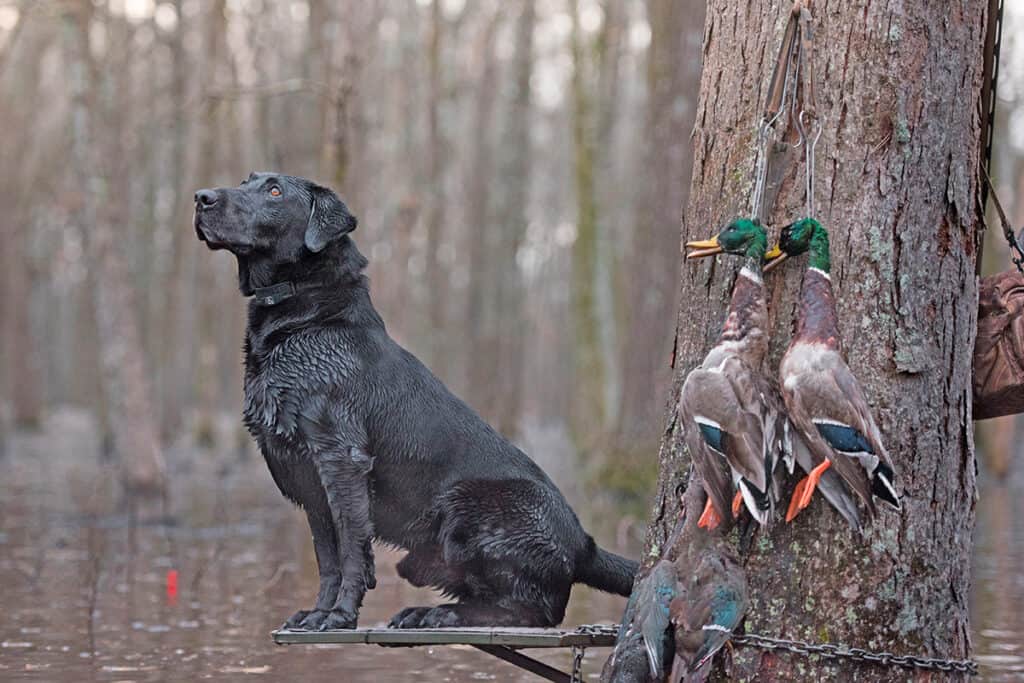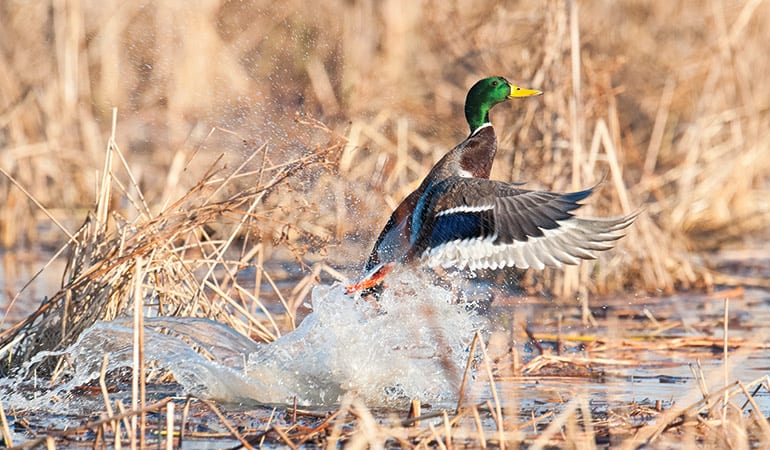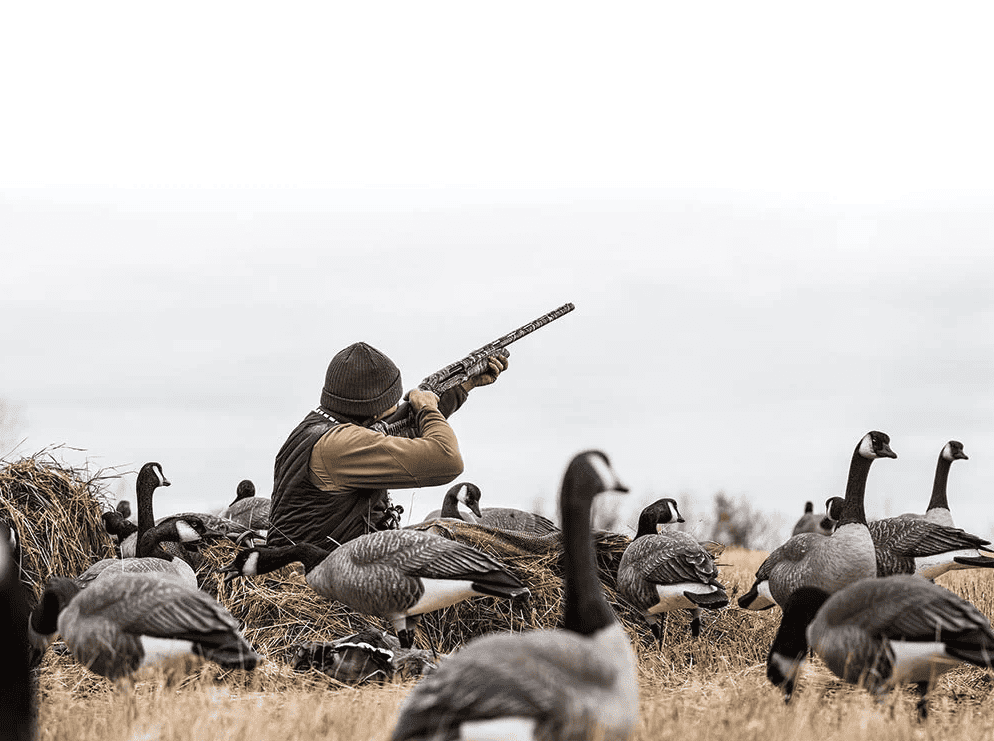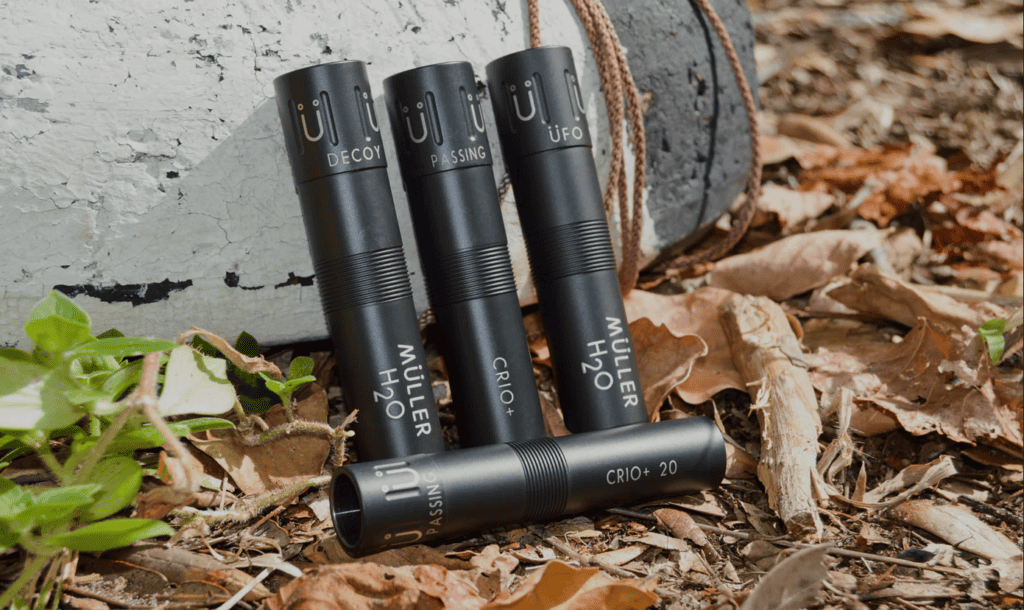The thought of duck hunting brings to mind heading out to the blind at the break of dawn, listening to the whistling of wings, and the smell of spent shells. Duck hunting involves quite a bit of specialized equipment. One piece that is often overlooked, although extremely important, is your shotgun’s choke! Which begs the question, what is the best size choke for duck hunting?
The best all-around choke size for duck hunting is hands-down the modified choke. This is a middle of the road choke size that offers plenty of effective range and pellet spread. There are no safety concerns with restricting steel shot through a modified choke like there is with a full choke.
There are several choke sizes, the most common ones are improved, modified, and full. The modified choke is the most versatile and most used. Different size chokes determine the effective range of a shotgun by constricting their pellet spread by different amounts.
Today, I will dive into depth on choke tube sizes and explain everything you need to know in order to choose the best size choke for your duck gun. Using the correct size choke on your next hunt will not only increase your accuracy and kill percentage but will also decrease the amount of money you end up spending on shells in the long run.

The Best All-Around Choke Size for Duck Hunting
You can find hundreds if not thousands of tests that average hunters, companies, and shooters have performed on different size choke tubes. They will use every size and brand of shot on the market today. Putting brands aside, we looked through tests solely done with regards to choke sizes and duck hunting shot ranges of 40 yards and in.
Some hunters claim that you want to use the tightest choke possible and have every shot be an “all or nothing” approach. This makes sense as far as limiting the amount of possible crippled ducks and loss and it may be the most conservation friendly approach.
Other hunters, mostly the ones hunting close combat areas such as flooded timber, swear by a choke that is more open, such as an improved cylinder. Especially on teal, they feel that the spread provides the greatest chance of a kill. It’s hard to debate that in close quarter hunting.
If you do hunt flooded timber, you will likely see plenty of wood ducks. If you don’t already have a fool-proof wood duck decoy spread, check out this article I recently wrote: Three Decoy Spreads Specifically For Wood Ducks
As we said, the best all-around choke size for duck hunting is hands-down the modified choke. This is a middle of the road choke size that offers plenty of effective range and knock-down power for all duck hunting situations. It’s a safe choke to use, and limits wear and tear on your tube.
Types of Chokes and How They Work
The purpose of a choke is to reduce the diameter of a gun’s bore, which will tighten the shot pattern and extend the effective range. For a shot to be considered effective, there must be at least 60 percent of the shot pattern within a 30-inch circle at the target.
For many hunters, changing the choke is as easy as screwing one in, but some older shotguns may have fixed choke barrels, so a different barrel (or shotgun) is your only option.
Restricting Choke
Most chokes work by constricting the shot as it leaves the bore. The tighter the choke the tighter your shot pattern and the further your effective range will be. To use an example, think of what happens when you squeeze the nozzle on a garden hose. The more you squeeze the nozzle the more constricted the water becomes. This produces a tighter stream that travels further.

Wad Stripper Choke
Another type of choke is referred to as a wad stripper choke. Patternmaster is the leader in wad stripper chokes. They are non-constrictive and use a stud ring that stops the wad for a split second, allowing the shot to continue undisturbed by the wad and the gasses. Patternmaster claims that their wad-stripper chokes can tighten a pattern by 80 percent.
Choke Sizes
There are several sizes of choke tubes available. In order, from open to tight, they are cylinder, skeet, improved skeet, improved cylinder, light modified, modified, improved modified, light full, full, extra full, and turkey. For duck hunting, use choke sizes that range from improved cylinder to full. Each choke size will constrict the bore by .005 inches more than the last. That may not seem like a lot, but let me assure you, it is.
Improved cylinder chokes are often used for upland game hunting such as quail, woodcock, and grouse. This is also a popular size among duck hunters that are hunting in tight areas such as flooded timber where their shots are close, and a larger pattern is more desirable. The effective range is out to about 30 yards.
A modified choke is the most common for duck hunters and for good reason. The versatility is unmatched, and it is as close to a “one size fits all” approach that can be used in any duck hunting situation. It is a middle of the road for constriction and can be used for just about all hunting situations. The effective range is about 40 yards.
A full choke is the tightest of the chokes used for waterfowl hunting. It is widely debated whether it is safe to shoot steel shot through a full choke because of the constriction of such a hard metal. Many hunters have done it and still do, but there are possible safety concerns and wear and tear on the choke. A full choke with steel shot will be effective out to about 50 yards. Just make sure you check the safety regulation on your specific choke before buying shells.
Changing Choke Size Based on Your Hunt
Ducks are hunted in a variety of habitats and locations. These locations and methods may include an open bay or ocean, a river bend, decoying ducks in a swamp, hand to hand combat in the flooded timber, or even floating a favorite creek and jump shooting from a canoe. Whatever it may be, the best choke size will change based on the location of your hunt.
In the flooded timber, the shots will be closer. In this case, a larger pattern with a shorter effective range is more desirable. An improved cylinder, also known as a Skeet II choke, may be your best option.
A full choke would be the best option when hunting any place where you expect to have longer shots, either when pass shooting or hunting wide open areas. In these situations, it is very possible to have longer shots and there’s no need to get caught with a choke that won’t allow your shot to effectively hit your target.
A modified or tighter choke is the best choice for sea duck species. Anyone that has ever shot sea ducks, will tell you that they are as tough to kill as they are to eat. Use a choke size that allows you to limit the number of crippled ducks, and that also enables you to put a finishing shot on a duck that dives, which may resurface at the far reaches of your range.

Patterning is Key to Success
Now that you have a choke size in mind that will fit your needs in the blind, don’t just screw it in the bore of your shotgun and head out to the field! No hunter would grab a rifle, put a scope on it and head out hunting without sighting in the scope first. In the same way, duck hunters shouldn’t head out without patterning their shotguns.
Not all guns are created equal. Neither are choke brands, and not all types of shot and choke combinations will shoot the same. First, get a choke that fits your gun and is rated correctly for the shot you are using whether it be steel, tungsten, or bismuth. Now take that to the range and get shooting.
Patterning your gun is simple. You can take a cardboard box and draw a 30-inch diameter circle and set it at different ranges. Shoot at each range and see where the pattern hits. The maximum effective range is based on the furthest shot where at least 60 percent of the pattern is contained in that 30 inch circle.
You may notice that the pattern has “holes” in it where no shot hit the target, or maybe it is not
centered with the bead. This is possibly the result of having a choke that does not work well with your shotgun and shot combination.
To limit the cost of buying and trying out different chokes, take a look online or talk to other hunters and narrow down your search. Plenty of tests have been published using just about every combination of choke size, brand, shot, and gun manufacturer. You can find videos and chart breakdowns that will help narrow down the search for the best choke for you.
How Does Shot Size and Material Affect Choke Size?
The ability to use lead shot for waterfowl was banned throughout the United States in 1991. At the time, this left only one option for shot material, steel. Nowadays, you can find shot that is also made from tungsten and bismuth. These materials were produced as an alternative to steel shot for those that wanted to use a heavier shot that performed more closely to lead.
The material used to make shot is important. Lead is somewhat soft and can be constricted without issue through tight choke sizes. Steel on the other hand is much less forgiving and is a harder material that doesn’t have the ability to compress as much as lead. This is especially important to consider when choosing a shotgun choke size for duck hunting because using a full choke may pose a safety risk.
Some chokes are labeled for use specifically for certain materials, so be sure to look at the packaging to decide if the choke you have chosen is compatible with the shot that you are using.
Shot sizes must also be considered. It is in the duck hunters best interest to keep everything consistent from the range to the blind. Any possible shot size used in the field should also be patterned beforehand on the range.

The Correct Choke Size May Mean More Than Filling a Bag Limit
Shotgun chokes may not only be important to your personal success. Using the correct choke size will also help to reduce the number of ducks lost by hunters.
By all estimation, somewhere around 30% of all ducks that are shot are lost by hunters. This is an astounding number when you think of the overall number of ducks crippled by hunters across the country. One way to limit the loss of ducks by hunters is using the correct size choke.
The choke tube in your gun is probably the most forgotten piece of equipment a duck hunter has, but it may be the most important aside from the shotgun and shells. The choke is what influences the performance of each shot and if it will reach the target to effectively and ethically kill the duck that is whistling by.
Using the right choke size may in fact help conserve ducks too. If about 3 out of 10 ducks are lost, shooting a bag limit of 6 ducks may as well be a bag limit of 7 or 8. Take that 30 percent ratio and apply it to all the ducks harvested in 2020 (9.72 million) you come up with around 2.92 million ducks lost by hunters.
If that loss was cut down by half, there would be about 1.5 million ducks saved, which would help conserve duck species’ and increase the number of ducks in your spread year after year. So don’t overlook your choke. Use the correct size for your situation, pattern your gun, and take shots within your effective range. Using the correct choke may be vital to the conservation of this natural resource we enjoy.
Saving that many ducks overall would be awesome, but if you are interested in bringing in more ducks to your honey hole by any means, you should definitely read this article I wrote about How To Attract More Ducks To Your Pond [6 Proven Methods]
Getting a Bead on Choke Tubes
It is time for you to take a look at choke tubes and try them out! Find one compatible with your gun and shot selection, hit the range, and pattern the gun. From my experience, you will not be disappointed in the all around performance that the modified choke provides in the duck blind, especially if you are currently shooting a smooth bore shotgun (aka no choke at all).
It all hinges on your goals. Are you looking for the greatest effective range, the most knockdown power, or are you happy with an all or nothing approach? Like most things in hunting, there is no wrong answer. Just try out whichever choke you think is best first. If you aren’t getting the results you’d like, the cheaper option would be to play with your shot selection before buying a new choke. Either way, I am confident you are going to shoot more birds this year, have fun!
Sister Post | 14 Rare Duck Species and Where to Find Them
A sister post is another post that I have written that follows along with the same topic as the one you just read. After reading this article, you will probably like this next one even more! Here is a little teaser…
Duck hunting is absolutely amazing as long as you have one thing, ducks. No matter what species you are hunting, the sight of a group of ducks cupping into your decoys is enough to give you chills…Keep Reading
1| Cinnamon Teal
Cinnamon Teal are mostly found on the West Coast and Midwest of…Keep Reading
2| Barrows Goldeneye
Barrows Goldeneye mostly resides in…Keep Reading
Thank you for reading my article! I hope you enjoyed it, and if you have any questions or feedback, please send me an email at [email protected]. If you want to learn more about me or Omega Outdoors, visit my About Page. Otherwise, I hope you have a great day, and check out some of my other articles while you’re here!

